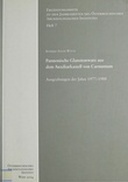Explore

Pannonische Glanztonware aus dem Auxiliarkastell von Carnuntum
Kristina Adler-Wölfl
2004
Bei der Pannonischen Glanztonware (PGW) handelt es sich um Keramikgattung, die vom Ende des 1. bis ins fortgeschrittene 3. Jh. n. Chr. in ganz Pannonien verbreitet gewesen ist. Sie ist ein Produkt lokaler Töpferwerkstätten, in dem sich die Einflüsse von in Latène-Tradition stehender und von importierter römischer Keramik zu einer neuen, typisch pannonischen Ware vereinigen.In dieser Ware wird ausschließlich Tafelgeschirr hergestellt. Die Gefäßformen sind großteils aus der Terra Sigillata übernommen bzw. von dieser beeinflußt; einige zeigen aber auch den Einfluß aus dem raetisch-germanischen Raum und aus der lokalen Gebrauchskeramik.Die Gefäße haben einen feinen Scherben, sind mit einem Glanztonüberzug versehen und am Beginn der Produktion meist reduzierend gebrannt. Von Anfang an treten - in regional unterschiedlichem Ausmaß - gleichzeitig aber auch oxidierend gebrannte Stücke auf, wobei ihr Anteil im 3. Jh. n. Chr. stark zunimmt. Der für die PGW typische florale bzw. ornamentale Stempeldekor auf der Innenseite am Boden oder auf der Außenseite der Wandung ist lediglich bei einem Teil der Gefäße anzutreffen; der Großteil der Gefäße ist ungestempelt.Grundlage der Untersuchungen zur PGW war das bei den Grabungen 1977-1988 unter der Leitung von H. Stiglitz im Auxiliarkastell von Carnuntum zutage gekommene Fundmaterial. Die Funde aus den Schichten des Steinkastells I und der darüber liegenden Planierungsschicht geben einen repräsentativen Überblick über die im zweiten Drittel des 2. Jh. im Raum von Carnuntum verwendete PGW.Auf der Basis des hier vorgelegten Fundmaterials wurde ein offenes Klassifikationssystem entworfen, das durch andere, bisher nur aus unpubliziertem Fundmaterial oder aus der Literatur bekannte Gefäßformen erweiterbar ist. Bezüglich des Materials konnten fünf Scherbentypen (STyp 1-5) und vier Überzugstypen (ÜTyp A-D) unterschieden werden.Neben dem sich aus der Materialbasis ergebenden Schwerpunkt im nordwestpannonischen Raum wird ein Überblick über das Spektrum der PGW, ihre Töpferstempel, Werkstätten und Funde aus datierten Fundorten im östlichen und südwestlichen Pannonien gegeben. Exkurse zu Südostpannonien, Moesien und Dakien runden das Bild ab.
This book is included in DOAB.
Why read this book? Have your say.
You must be logged in to comment.
Rights Information
Are you the author or publisher of this work? If so, you can claim it as yours by registering as an Unglue.it rights holder.Downloads
- 207 - pdf (CC BY-NC-ND) at OAPEN Library.
- 175 - pdf (CC BY-NC-ND) at OAPEN Library.
Keywords
- Aquincum
- Blatt (Pflanze)
- Carnuntum
- Ceramics
- Classification
- Keramik
- Klassifikation
- oxidation
- Pannonia
- Pannonian Glanztonware
- Pannonien
- Pannonische Glanztonware
- Reduktion (Chemie)
- Scherbentypen
- Schiffstyp
- The arts
- thema EDItEUR::A The Arts
- types of shards
- V. Chr.
- Yi I
Links
DOI: 10.26530/oapen_477713Editions

